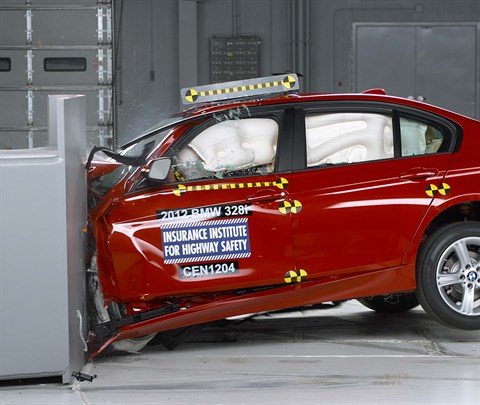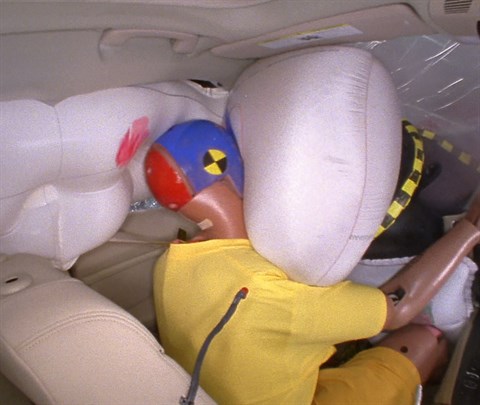Small overlap front: driver-side
Rating applies to 2012-15 models
Tested vehicle: 2012 BMW 328i 4-door
The BMW 3 series sedan was redesigned for the 2012 model year.
| Evaluation criteria | Rating |
|---|---|
| Structure and safety cage | |
| Driver injury measures | |
| Head/neck | |
| Chest | |
| Hip/thigh | |
| Lower leg/foot | |
| Driver restraints and dummy kinematics The dummy’s head loaded the frontal airbag which stayed in front of the dummy until rebound. However, the steering column moved upward 16 cm, resulting in little airbag cushioning for the chest. Additionally, the seat belt allowed excessive forward excursion of the dummy’s head and torso. The side curtain airbag deployed but does not have sufficient forward coverage to protect the head from contact with side structure and outside objects. | |

Action shot taken during the small overlap frontal crash test.

The dummy's position in relation to the door frame, steering wheel, and instrument panel after the crash test indicates that the driver's survival space wasn't maintained well.

During the crash, the seat belt allowed the dummy to move too far forward, as is evident from the gap between the seat back and the dummy's torso.

Intrusion into the occupant compartment was extensive as the left front wheel was forced rearward and inward into the driver's footwell during the crash. Left lower leg injury risk was high.
Moderate overlap front: original test
Rating applies to 2012-18 models
Tested vehicle: 2012 BMW 328i 4-door
The BMW 3 series sedan was redesigned for the 2012 model year. Moderate overlap frontal ratings are assigned by the Institute based on a test conducted by BMW.
| Evaluation criteria | Rating |
|---|---|
| Overall evaluation | |
| Structure and safety cage | |
| Driver injury measures | |
| Head/neck | |
| Chest | |
| Leg/foot, left | |
| Leg/foot, right | |
| Driver restraints and dummy kinematics | |
Side: original test
Rating applies to 2012-18 models
Tested vehicle: 2012 BMW 335i 4-door with standard front and rear head curtain airbags and standard front seat-mounted torso airbags
The BMW 3 series sedan was redesigned for the 2012 model year. Side ratings are assigned by the Institute based on a test conducted by BMW.
| Evaluation criteria | Rating |
|---|---|
| Overall evaluation | |
| Structure and safety cage | |
| Driver injury measures | |
| Head/neck | |
| Torso | |
| Pelvis/leg | |
| Driver head protection | |
| Rear passenger injury measures | |
| Head/neck | |
| Torso | |
| Pelvis/leg | |
| Rear passenger head protection | |
Roof strength
Rating applies to 2012-18 models
Tested vehicle: 2012 BMW 335i 4-door
| Overall evaluation | |
|---|---|
| Curb weight | 3,516 lbs |
| Peak force | 17,527 lbs |
| Strength-to-weight ratio | 4.98 |
Head restraints & seats
Seat type: Power leather seats
| Overall evaluation | |
|---|---|
| Dynamic rating | |
| Seat/head restraint geometry |
About the head restraint & seat test
Currently, IIHS tests apply only to front seats.
Front crash prevention: vehicle-to-vehicle
Ratings are given for 2 different trim variations available on this vehicle.
